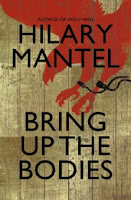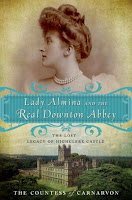 Review: Dreams of Joy
Review: Dreams of Joy
One of my first reviews for this blog was for Lisa See's
Snow Flower and the Secret Fan (click
here). And the first books I read by See were her mysteries, including
Flower Net, The Interior, and
Dragon Bones, all of which are amazing.
Whether set in ancient eras or in more modern times, See's books have one thing in common – the stories center around family and relationships.
Dreams of Joy continues on those themes, picking up immediately where the book
Shanghai Girls ended. Joy has just learned that her family is not what it seems, that her mother Pearl is actually her aunt and that her aunt May is her true mother. Distraught, she runs away from her Los Angeles Chinatown home to Shanghai to find her birth father, a famous artist named Z.G. Li.
But there's a complicating factor. The China that sisters Pearl and May knew as young women has changed dramatically, with Mao Zedong and the Communist Party of China solidifying their power. Like some in the '50s, Joy has an idealistic notion of Communism, seeing it as a solution to corrupt capitalism and the only way to achieve balance between rich and poor.
As she reunites with Z.G. in Shanghai, her naivete keeps her from seeing the implied threat in the order that sends her artist father to Green Dragon Village, a collective in Anhwei province where he must teach art to the peasants. Just 250 miles from Shanghai, the village is like another world, with no cars, electricity, plumbing or phones.
As Joy and Z.G. settle into the village, Pearl takes the dangerous step of following Joy to Shanghai. With travel within China restricted, she must wait in the city for Joy's return, while trying to blend in and not attract notice from the authorities.
Joy and Z.G. travel to Peking for an art exhibit, even meeting Mao himself who chooses Z.G.'s painting of Joy for a propaganda poster that is soon showcased all over China – reminiscent of Z.G.'s early "beautiful girl" paintings of May and Pearl.
Returning to Shanghai, Joy and Z.G. are confronted by Pearl, who wants to return to America with the woman she raised as her own daughter. Joy refuses and insists on returning to Green Dragon Village just as Mao institutes the disastrous Great Leap Forward, a program designed to make China overtake the West in agriculture and steel production in just a few years. Bizarre ideas that are forced on the country – such as planting six times the normal amount of wheat in a field or sowing the ground with glass as a "nutrient" – lead to famine, widespread disease and death.
A disillusioned Joy, who is now married and has a baby, sends a desperate message to Pearl and Z.G., who race to save her before she becomes yet another statistic of the starvation and deprivation that grip China.
Dreams of Joy is a gripping account of a convulsive period in Chinese history, but again it is also a touching story of the love between mothers and daughters, and of sacrifices of the heart.
(2011 – Random House)
Recipe: Lisa See's Curried Tomato Beef
My sincere thanks to Lisa See for providing this recipe. She wrote all of the following copy:
"Food is memory, and many of my memories are linked to food. This recipe has grown and evolved over three generations in my family. My grandfather used to own a restaurant in Los Angeles Chinatown called Dragon’s Den. It was only the seventh family-style Chinese restaurant in Los Angeles. Back in 1936, when Dragon’s Den opened, this dish – minus the curry and the noodles – cost just twenty-five cents. The restaurant had closed by the time I was born, but I can remember my grandfather making a version of the Dragon’s Den tomato beef at home.
"Tomato beef is a uniquely Chinese-American dish – symbolic in many ways of the 'melting pot.' 'Mein' means noodles in Cantonese, but beef and tomatoes are not typical Chinese ingredients. But in the past, if you were Chinese and lucky enough to own your own restaurant, you put together ingredients you thought would please your American customers. That’s how American tomatoes and beef came to be thrown together with Chinese noodles. For a time tomato beef lo mein and curried tomato beef lo mein could be found on every menu in Chinese-American restaurants and cafés, such as the Golden Dragon Café. Now you can’t even find tomato beef in Chinese restaurants! No one asks for it, orders it, or remembers it. So this truly is a taste of the past, specifically 1950s Chinese America. There is no right or wrong way to make this dish. It’s all about your personal taste and whether you like more vinegar or sugar."
1 lb. flank steak – cut into ¼" strips against the grain
2 teaspoons soy sauce
1 teaspoon dry sherry
1 teaspoon sesame oil
½ teaspoon salt
Pepper to taste
1 teaspoon cornstarch
2-3 Tbsp. canola oil
1 medium to large onion – cut into 1"squares
1 green bell pepper – chopped into 1" squares
4 roma tomatoes – quartered
1 Tbsp. Madras curry powder
4-6 Tbsp. white vinegar
1-3 teaspoons white sugar
Cilantro – loosely chopped
1 lb pasta
Mix ingredients for marinade (soy sauce, sherry, sesame oil, salt, pepper, and cornstarch) and add sliced beef. Let marinate for 20 minutes.
Put oil in a wok (or frying pan) over high heat. When oil is hot and smoking, add the beef and stir fry until browned but not fully cooked. Add the onion and bell pepper. After they’ve cooked for a while (but are still crisp), add the curry powder, vinegar, and sugar. Add tomatoes and cook until just heated through. (You don’t want the vegetables to lose their shape. They should remain whole and crisp.) Taste for flavor. The sauce should be strong, because it will be toned down by the noodles (or rice).
Meanwhile, in a separate pot, heat water and cook the noodles of your choice according to package instructions. When done, drain the noodles and put them on a platter. Pour the curried tomato on top of noodles, sprinkle with chopped cilantro, and serve.
• For the more health conscious, you can substitute chicken for the beef. My dad fries boneless, skinless chicken thighs until they’re done enough to cut them up easily. Then he adds them back to the wok after the onion and bell pepper to cook a bit more.
• Some people like to add the noodles to the wok and toss them with the other ingredients. Transfer to a platter and sprinkle with cilantro.
 I've said here many times that I really like Janet Evanovich's Stephanie Plum series. Is it Pulitzer-worthy writing? No. But it is highly entertaining and fun, and I have laughed my way all the way through the books. So it's a shame that it didn't translate to the screen with the same entertainment value.
I've said here many times that I really like Janet Evanovich's Stephanie Plum series. Is it Pulitzer-worthy writing? No. But it is highly entertaining and fun, and I have laughed my way all the way through the books. So it's a shame that it didn't translate to the screen with the same entertainment value. 






















